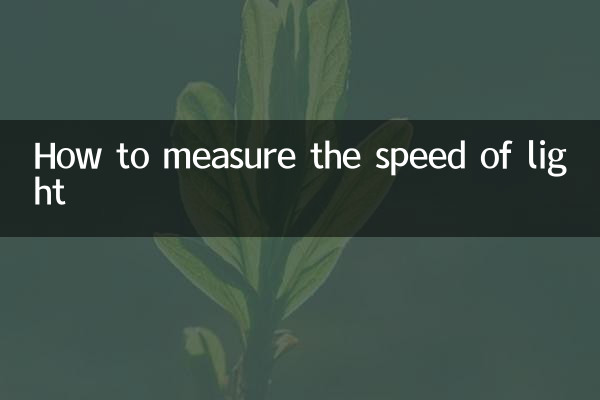How to measure the speed of light
The speed of light is a basic constant in physics, and its accurate measurement is of great significance to scientific research and engineering technology. This article will introduce in detail the measurement method, historical background and relevant experimental data of the speed of light.
1. Historical background of light speed measurement

Measurements of the speed of light date back to the 17th century. Galileo tried to measure the speed of light through light signals, but failed due to experimental conditions. It was not until 1676 that Danish astronomer Ole Roemer first estimated the finite speed of light by observing the eclipses of Jupiter's satellites. Since then, scientists have continued to improve measurement methods and gradually increased the accuracy of measuring the speed of light.
| years | the scientist | Measurement method | Measured value (km/s) |
|---|---|---|---|
| 1676 | Ole Romer | Jupiter eclipse observation | About 220,000 |
| 1849 | Armand Fizeau | rotating gear method | Approximately 315,000 |
| 1926 | albert mikeson | rotating mirror method | 299,796±4 |
| 1983 | International Bureau of Weights and Measures | laser interferometry | 299,792.458 (defined value) |
2. Modern methods of measuring the speed of light
Modern light speed measurement mainly relies on laser technology and precision timing equipment. Here are a few common measurement methods:
1. Laser interference method
Laser interferometry calculates the speed of light by measuring the wavelength and frequency of laser light. Since the product of frequency and wavelength is equal to the speed of light, this method has extremely high accuracy. In 1983, the International Bureau of Weights and Measures defined the speed of light as 299,792.458 km/s and redefined the length of the meter based on this.
2. Microwave resonant cavity method
The microwave resonant cavity method uses the standing wave characteristics of microwaves in the resonant cavity to measure the speed of light. By measuring the resonant frequency and cavity size, the speed of light can be calculated. This method is suitable for precise measurements under laboratory conditions.
3. Time flight method
The time-of-flight method calculates the speed of light by measuring the time it takes for a light pulse to travel over a known distance. This method requires highly accurate time-measuring equipment, such as atomic clocks.
| Measurement method | Accuracy | Applicable scenarios |
|---|---|---|
| laser interferometry | extremely high | laboratory |
| Microwave resonant cavity method | high | laboratory |
| time flight method | medium | field experiment |
3. The significance of light speed measurement
The precise measurement of the speed of light not only promotes the development of physics, but also provides the basis for modern communications, navigation and astronomical observations. For example, the Global Positioning System (GPS) relies on precise values of the speed of light to calculate location information. In addition, the speed of light, as a fundamental constant of nature, plays a central role in the theory of relativity and quantum mechanics.
4. Future Outlook
As technology advances, the accuracy of light speed measurement is expected to be further improved. Scientists are exploring the use of new phenomena such as quantum entanglement to measure the speed of light, which could open up entirely new areas of research.
In short, the measurement of the speed of light is an important milestone in human scientific exploration. From early astronomical observations to modern laser technology, every breakthrough has advanced human understanding of the natural world.

check the details

check the details